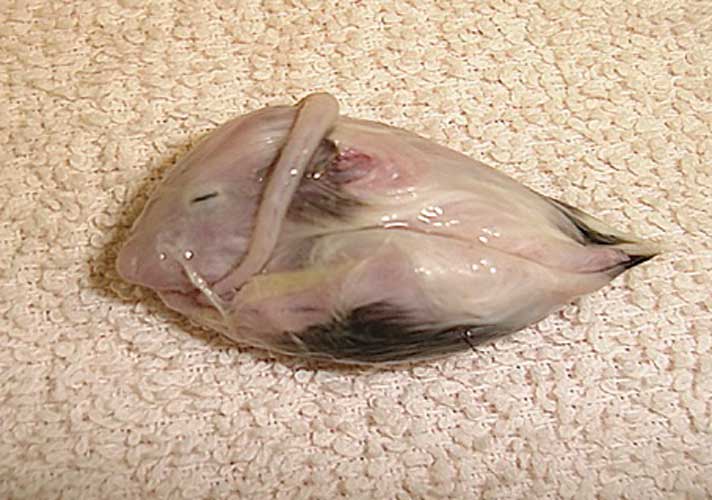The two most common causes of vomiting or regurgitation in snakes are low-environmental temperature and handling the animal too soon after eating.
A million years ago, back when I thought I knew everything about herp medicine, vomiting was on the top of my list for common diseases in sick reptiles. I think mouth rot, shedding problems, pneumonia and mites rounded out the top five conditions.

Douglas Mader
This mouse was regurgitated from a recently fed snake. If your herp vomits or regurgitates after eating, be sure to bring the vomit with you to the veterinary examination! There is valuable information that can be learned by examining the discharged food item.
Vomiting is a common problem, and a frequent reason for veterinary visits. Vomiting, and it close relative, regurgitation, in snakes (and to a lesser extent, lizards) is not uncommon.
Before I go into a discussion on causes and cures, let me point out the important difference between the two behaviors. Vomiting refers to food that is expelled from the lower gastrointestinal tract (below the stomach), and regurgitation refers to food that is expelled from the stomach and above. The distinction may seem insignificant, but from a medical perspective, it makes a difference.
In reality, the most common cause for either condition usually stems from one or two minor husbandry or management problems. However, there are a few cases where the cause is not obvious, and it can be both frustrating and costly before an accurate diagnosis is made and treatment is initiated.
Want To Learn More?
Gecko Lizard Regurgitating And Light-Colored Liver
The two most common causes of vomiting or regurgitation in snakes are low-environmental temperature and handling the animal too soon after eating. The following is a typical scenario. A person owns a pet snake (usually their first pet snake) and keeps it in a terrarium. They are told to keep it warm, so they put a light over its cage during the day. This makes the cage warm enough to stimulate its appetite, so that when they feed it, it eats ravenously.
At night, the conscientious owner turns out the light so that the snake can sleep. But the cage temperature then drops down below the optimum for the snake to carry out the many processes involved in normal digestion. If the food item remains in the snake’s stomach, it will rot and then act as a medium for bacterial growth. The snake’s body protects against this by vomiting up the food when the environmental temperature drops below a certain level.
The solution is simple. Alternate methods for heating the cage at night need to be employed. Examples include heating pads, heat strips and radiant heaters (ceramic heat emitters; red or amber bulbs work best). Be careful when using these types of heating devices that they do not get too hot. Always have at least one thermometer in the cage to monitor temperature.
Handling snakes too soon after eating is the second major cause of regurgitation. After a snake eats in the wild, its normal pattern of behavior includes finding a secluded spot to stay for a few days, where it can rest and digest its meal. During this time, it will display very little activity.
If the animal gets stressed of startled, such as by a potential predator, a full stomach makes fight or flight difficult. It then regurgitates its food item, thus evacuating its stomach, which makes activity much easier.
The solution is equally as simple. Leave the snake alone, that is, do not handle it, for a few days post-feeding. Some snake species like to soak in water for a few days after a meal, so be sure to provide a water container large enough for the animal to coil up within.
I would say that these two conditions account for approximately 90 percent of the vomiting/regurgitation problems seen in snakes. These are easily diagnosed. A thorough examination of your husbandry and management practices should reveal the problem areas. If you have questions, have an expert review your situation.
There are a number of other causes that make up the remaining 10 percent of vomiting cases. There are several diseases that can cause a snake to vomit or regurgitate shortly after taking a meal. The exact mechanisms are beyond the scope of this article, but some of the causes can include bacteria, fungal infections, viruses, parasites, obstructions, cancer, kidney, liver and pancreatic diseases, and brain damage. The diagnosis of some of these conditions can be as simple as examining a routine fecal sample or as intricate as performing elaborate laboratory tests or even an MRI. Unfortunately, some of these latter tests can be quite costly.
An example of a common parasite that causes regurgitation in snakes is frequently seen in corn snakes, an organism called cryptosporidiosis. This can be difficult to diagnose at times, and interpreting the tests results can be confusing. Worse, there is no treatment currently available and the disease is contagious to other reptiles. If you have a herp that has been diagnosed with cryptosporidiosis, it is imperative that you follow strict quarantine procedures so that other animals in your collection do not get sick.
The best advice for owners of vomiting snakes is to critically evaluate your husbandry practices. As mentioned, it may be worth having someone with experience assess your management and housing. If the problem cannot be readily identified, then a visit to your local reptile veterinarian should follow as soon as possible. When caught in time, many of these diseases are treatable.
Douglas R. Mader, MS, DVM, DABVP (REPTILE/AMPHIBIAN), is a graduate of the University of California, Davis. He owns the Marathon Veterinary Hospital in the Conch Republic, and is a world-renowned lecturer, author and editor. He sits on the review boards of several scientific and veterinary journals.


